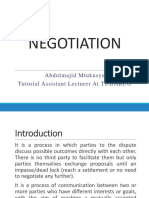CHAPTER – 1
NEGOTIATION
1.1 Introduction
Negotiation can be defined as: "To communicate with the objective of reaching an agreement by
means, where appropriate, of compromise. Simply speaking it is a discussion intended to
produce an agreement.
Negotiation is a dialogue between two or more people or parties, intended to reach an
understanding, resolve point of difference, or gain advantage in outcome of dialogue, to produce
an agreement upon courses of action, to bargain for individual or collective advantage, to craft
outcomes to satisfy various interests of two people/parties involved in negotiation process.
Negotiation is a process where each party involved in negotiating tries to gain an advantage for
themselves by the end of the process. Negotiation is intended to aim at compromise.
Negotiation occurs in business, non-profit organizations, government branches, legal
proceedings, among nations and in personal situations in everyday life.
Example: Two sisters were negotiating, arguing actually, over possession of their last orange,
so the story goes. Finally, they decided to split it in half. The elder sister took her half of the
orange and used only the rind for baking, throwing away the pulp. The younger sister squeezed
her half to make juice and threw away the rind. If they had been better at negotiating, they
would have realized that both could have come out ahead, one getting all of the rind and the
other getting all the fruit. This simple parable shows one of many aspects of negotiation.
1.2 Negotiation & Negotiator
Negotiation is a technique of discussing issues among one selves and reaching to a conclusion
benefiting all involved in the discussion. It is one of the most effective ways to avoid conflicts
and tensions. When individuals do not agree with each other, they sit together, discuss issues
on an open forum, negotiate with each other and come to an alternative which satisfies all. In a
layman’s language it is also termed as bargaining.
Negotiator is an individual representing an organization or a position who listens to all the
parties carefully and comes to a conclusion which is willingly acceptable to all is called the
negotiator.
1.3 Skills of a negotiator
A negotiator ideally should be impartial and neutral and should not favour any one. He needs to
understand the situation and the parties well and decide something which will benefit all. It is not
always that people will easily accept the negotiator’s decision; they may counter it if they feel
their personal interests are not satisfied. In such a situation, where the negotiator is left with no
choice, he must use his power to impose his ideas on all, after all one can’t please everyone. A
negotiator has to be a little tactful and smart enough to handle all situations and reach to a
conclusion.
�1.4 Types of Negotiators
Three basic kinds of negotiators have been identified by researchers involved in The Harvard
Negotiation Project. These types of negotiators are: Soft bargainers, hard bargainers, and
principled bargainers.
Soft: These people see negotiation as too close to competition, so they choose a gentle
style of bargaining. The offers they make are not in their best interests, they yield to
others’ demands, avoid confrontation, and they maintain good relations with fellow
negotiators. Their perception of others is one of friendship, and their goal is agreement.
They do not separate the people from the problem, but are soft on both. They avoid
contests of wills and will insist on agreement, offering solutions and easily trusting others
and changing their opinions.
Hard: These people use contentious strategies to influence, utilizing phrases such as
“this is my final offer” and “take it or leave it.” They make threats, are distrustful of others,
insist on their position, and apply pressure to negotiate. They see others as adversaries
and their ultimate goal is victory. Additionally, they will search for one single answer, and
insist you agree on it. They do not separate the people from the problem (as with soft
bargainers), but they are hard on both the people involved and the problem.
Principled: Individuals who bargain this way seek integrative solutions, and do so by
sidestepping commitment to specific positions. They focus on the problem rather than
the intentions, motives, and needs of the people involved. They separate the people
from the problem, explore interests, avoid bottom lines, and reach results based on
standards (which are independent of personal will). They base their choices on objective
criteria rather than power, pressure, self-interest, or an arbitrary decisional procedure.
These criteria may be drawn from moral standards, principles of fairness, professional
standards, tradition, and so on.
1.5 Some Truths about Negotiation
While considering negotiation, let us first look into some basic principles that hold good in all
negotiable situations.
Negotiation is entirely a voluntary activity. Either of the parties can refuse to negotiate at
any time.
Whatever be the topic and kind of negotiation, the outcome is largely dependent on the
values, attitudes, personal beliefs and emotions of the people at the table.
Negotiation starts because at least one or both the parties feel dissatisfied with the
present situation. The want to change and the belief that a mutually agreeable solution is
possible.
A successful negotiation is not always a win-lose situation. It is both parties being
satisfied with the result.
Timing is an extremely important factor in negotiation. Coming up with the right proposal
at the right time invariably decides the success of the negotiation activity.
�1.6 Elements of Negotiation
Following are the Elements of Negotiation
Process- The way individuals negotiate with each other is called the process of
negotiation. The process includes the various techniques and strategies employed to
negotiate and reach to a solution.
Behavior- How two parties behave with each other during the process of negotiation is
referred to as behavior. The way they interact with each other, the way they
communicate with each other to make their points clear all come under behavior.
Substance- There has to be an agenda on which individuals negotiate. A topic is
important for negotiation. In the first situation, going for the late night movie was the
agenda on which you wanted to negotiate with your parents as well as your friends.
Negotiation
Process + Behavior + Substance (Agenda)
To conclude, negotiation is simply a technique, a discussion among individuals to reach to a
mutual agreement where everyone gains something or the other and conflicts are avoided.
1.7 Preparing for a Successful Negotiation
Depending on the scale of the disagreement, some preparation may be appropriate for
conducting a successful negotiation.
For small disagreements, excessive preparation can be counter-productive because it takes
time that is better used elsewhere. It can also be seen as manipulative because, just as it
strengthens your position, it can weaken the other person's.
However, if you need to resolve a major disagreement, then make sure you prepare thoroughly.
Think about the following points before you start negotiating:
Goals: what do you want to get out of the negotiation? What do you think the other
person wants?
Trades: What do you and the other person have that you can trade? What do you
each have that the other wants? What are you each comfortable giving away?
Alternatives: If you don't reach agreement with the other person, what alternatives
do you have? Are these good or bad? How much does it matter if you do not reach
agreement? Does failure to reach an agreement cut you out of future opportunities?
And what alternatives might the other person have?
Relationships: What is the history of the relationship? Could or should this history
impact the negotiation? Will there be any hidden issues that may influence the
negotiation? How will you handle these?
� Expected outcomes: What outcome will people be expecting from this negotiation?
What has the outcome been in the past, and what precedents have been set?
The consequences: What are the consequences for you of winning or losing this
negotiation? What are the consequences for the other person?
Power: Who has what power in the relationship? Who controls resources? Who
stands to lose the most if agreement isn't reached? What power does the other
person have to deliver what you hope for?
Possible solutions: Based on all of the considerations, what possible compromises
might there be?
1.8 Style is Critical
For a negotiation to be 'win-win', both parties should feel positive about the negotiation once it's
over. This helps people keep good working relationships afterwards. This governs the style of
the negotiation – histrionics and displays of emotion are clearly inappropriate because they
undermine the rational basis of the negotiation and because they bring a manipulative aspect to
them.
Despite this, emotion can be an important subject of discussion because people's emotional
needs must fairly be met. If emotion is not discussed where it needs to be, then the agreement
reached can be unsatisfactory and temporary. Be as detached as possible when discussing
your own emotions – perhaps discuss them as if they belong to someone else.
1.9 Negotiating Successfully
The negotiation itself is a careful exploration of your position and the other person's position,
with the goal of finding a mutually acceptable compromise that gives you both as much of what
you want as possible. People's positions are rarely as fundamentally opposed as they may
initially appear – the other person may have very different goals from the ones you expect!
In an ideal situation, you will find that the other person wants what you are prepared to trade,
and that you are prepared to give what the other person wants.
If this is not the case and one person must give way, then it is fair for this person to try to
negotiate some form of compensation for doing so – the scale of this compensation will often
depend on the many of the factors discussed above. Ultimately, both sides should feel
comfortable with the final solution if the agreement is to be considered win-win.
Only consider win-lose negotiation if you don't need to have an ongoing relationship with the
other party as, having lost, they are unlikely to want to work with you again. Equally, you should
expect that if they need to fulfill some part of a deal in which you have "won," they may be
uncooperative and legalistic about the way they do this.
1.9.1 Negotiation Styles and their Contexts
Depending on the context and the people involved in negotiation, we adopt different styles for
optimum effect. The following are some of the negotiation styles we generally use:
As we see, different styles are used in different situations. There cannot ever be one style that is
true of all situations. A successful negotiator will always judge the situation; the people involved
and decide on an appropriate style.
� Negotiation Styles When to be used
1. Collaborating: A cooperative approach Issues are very important and involve long-
that stresses on win-win stance. Requires term relationship.
creative problem solving. Commitment from both sides is necessary
for success.
2. Compromise: Here, both parties accept There is only this alternative to a no
some amount of win and loss. The objective is solution situation.
to find a solution that both parties will accept. You need short-term settlements.
The opponents are equally powerful.
Long-term interests of both have to be kept
in mind.
3. Control: Here, one ensures that one’s The action will be resented, but the issue is
personal goals are met whatever be the very important.
consequences. It is a power-oriented You know that the other party will take
approach where the only aim is to win. advantage of your cooperative behavior.
Quick action is vital and you believe that
you are right.
4. Accommodation: The priority here is You wish to create a platform for more
conflict avoidance. It can be seen as lose-lose important issues to come up.
or lose-win approach that allows the other You are in a weak position and you wish to
party to win. minimize loss.
Harmony and stability are more important
that winning.
5. Avoidance: This style is characterized People need to cool down.
by evasiveness and withdrawal from the issue You are buying time.
at hand. There are more important issues
pressurizing you.
There is no solution and you want time to
resolve the issue.
1.9.2 Know Your Opponent
Before you begin a negotiation, it helps not only to know your opponent but know how to deal
with the type of person he/she is. For convenience, plot him along the two axes and see into
which quadrant he falls.
Practical/realistic A B Humane/intimate
Objective/cool C D Speculative/creative
� Pick up evidence about your opponent from the way he/she answers telephone calls, the
tone of his/her voice, the way the way he/she responds to your statements, how he/she wants
the agenda to be organized and what his/her office looks like. Finally, organize your arguments
to suit his/her type.
A person can be of the type A, B, C OR D. Take time to know the person and suit your
arguments accordingly.
Type A
i. Adopt a matter-of-fact tone.
ii. Tackle exact questions.
iii. Talk of real benefits.
iv. Expect critical/probing questions.
v. Don’t lie. Most probably, you’ll be caught.
Type B
i. Adopt a warm style.
ii. Emphasis harmony.
iii. Talk of long-term relationships.
Type C
i. Stress on long-term benefits.
ii. Expect to be probed in depth.
iii. Don’t presume.
iv. Engage yourself in probing alternative possibilities.
Type D
i. Try to build sincerity and warmth.
ii. Most probably, he will have a vision. Play it back to him.
iii. Focus on possibilities of developing people.
iv. Tailor your details to suit him.
1.10 Common Hurdles in Negotiation
Negotiation is an extremely delicate activity; if things go wrong, it becomes very difficult to set
them right and put the negotiation back on the track. It is sensible, thus, to approach a
negotiation cautiously and avoid committing mistakes. Some of the common mistakes that
people make during negotiations are the following:
1.10.1 Becoming Uni-dimensional
Often we enter a negotiation with a predetermined notion of the outcome. This makes us rigid
and incapable of looking at other perspectives. Rigidity results in the creation of deadlocks
leading to failure. This happens when one of the negotiating parties imposes a point without
bothering about the understanding of the other party. This can cause frequent interruptions and
explicit expressions of frustration, resulting in the outright rejection of the others’ viewpoints.
�Troubleshooting
i. Always be on the lookout for non-verbal clues of disagreement, resentment or
disapproval. Encourage the other party to come out with their objections and look at the
problem from their perspective.
ii. Look at your own agenda only as a framework that can be changed, altered or even
rejected.
iii. During the discussion, summarize intermittently and give reviews of what is going on.
This will place the discussion in the right perspective and enable both parties to view it
objectively.
iv. Treat the information you have and what others give you as hypothesis rather than facts.
1.10.2 Adopting Win-Lose Attitude
Often we go to the negotiation table wit the idea that it is a battlefield where we should win. This
can have dangerous consequences. It can result in your not appreciating the other’s
point of view and trying to impose your perspective as the only correct one. Worse stills,
it can result in personal attacks and emotional outbursts.
Troubleshooting
i. Search for common ground in the discussion. Highlight them and see if any solution can
flow from it.
ii. Try hard to understand the other’s perspective and avoid attacking or becoming
defensive.
iii. Think in terms of your long-term relationship and more importantly, do not lose sight of
the real interest involved in the dispute.
1.10.3 Escaping Conflict
At times, we face problems because the real issue goes unaddressed or gets addressed only
peripherally. During such a session we rarely have a well-set agenda and frequently the parties
shift to more comfortable topic rather than squarely addressing the problem at hand. Sometimes
even concessions are made unthinkingly which can land both the parties involved, in trouble
later. If the avoidance is not deliberate, then it could be due to lack of proper preparation or the
inability to rightly estimate the requirements of negotiation.
Troubleshooting
i. It the conflict is not serious, leave it alone. Time solves many such problems.
ii. Attempt to affect the motivation of the other party if you find them not motivated.
iii. Prepare well, gather information, identify points where agreement could be reached and
adopt an open and encouraging attitude to ensure serious participation of the other
party.
�1.11 Negotiating Cultural Diversities
With increased globalization, it has become a necessity these days to interact with
different cultures and negotiate a variety of matters. Intercultural negotiation sometimes poses
problems because what is acceptable and desirable in one culture may well be rejected in
another culture. Different groups have different ideas about protocol and procedure. The
emphasis given to preliminaries varies so also the manner in which various elements are
approached and tackled.
Japanese, for instance, consider good negotiators, to be people who are able to
perceive and exploit power, who have high integrity, listening skills and verbal expressiveness.
Americans feel that good product knowledge along with verbal ability makes for a good
negotiator. According to the Chinese, a good negotiator must firstly be an interesting person,
have good judgment, product knowledge and intelligence. The following parameters can be a
good guide to judge the appropriate response in different cultures:
1.11.1Parameters to Judge Different Cultures
(a) Individualism
Are people expected to be loyal to their group or organization or themselves?
Do individual interests prevail over collective interests or vice-versa?
Are hiring, rewarding and promotion decisions, dependent on the individual’s
achievements and responsibilities?
Are rules considered absolute or negotiable?
Are deviant patterns of behavior acceptable or are they considered dangerous?
Are people allowed to disagree openly with superiors?
Are people allowed to express anger, aggression and other emotions?
(b) Status/Power Differences
Is power based on family background, gender, age or individual ability?
Do prevailing systems emphasize hierarchy?
Does the law stress on equal rights or is inequality among people expected and desires?
Are status symbols and privileges for the powerful accepted, popular or debunked?
(c) Time Perception
Is punctuality considered a virtue?
Are people occupied primarily with their past, present or future?
Are tasks and deadlines scheduled very tightly or comfortably?
Is time considered short and expensive or inexpensive and flexible?
(d) Personal Relationships
Are personal relationships more important than rules and regulations?
Are business contracts based on informal network and private understanding?
Are relationships close and long lasting?
These are some of the parameters you can use to develop awareness about how you have
to negotiate with people from different cultures. Remember that cultures have deep-seated
biases. These are bound to influences people’s negotiations styles. Awareness of these will
help you know and understand their responses better and eventually help you negotiate better.
Activity
�Go to the internet and try to evaluate the importance of the following in the four given cultural
set-ups. Evaluate each as very important, moderately important and unimportant.
Pakistani British Japanese American
Punctuality
Sense of hierarchy
Honesty
Professionalism
Interpersonal relationship
Privacy
Individualism
Adherence to social norms
























































































